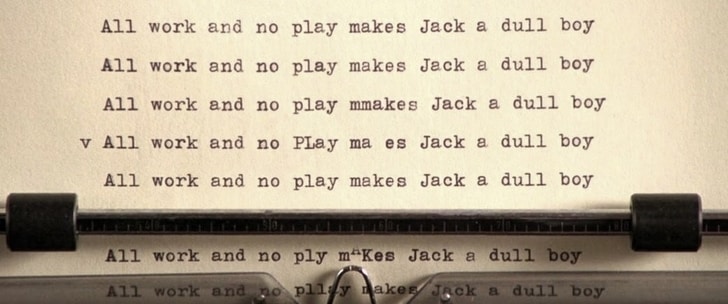Writing is hard, there’s no denying it. Sitting down staring at a computer, typewriter or piece of paper and putting words together to create a story is difficult. It can feel like standing at the bottom of a mountain, wondering how on Earth you’re going to get up to the top. However, creating a writing schedule and writing routine is a simple way to make the impossible seem possible.
Establishing a writing routine is pivotal to making writing a part of your life. Having a writing schedule allows you to have a life that involves writing instead of a life that is controlled by how much you can write.
There are many aspects that make up a writing schedule and routine and in this article, we’ll explore these so that you can get the most out of your writing. This guide will provide ideas and inspiration for you to create your own schedule, which will then become a routine.
Table of Contents
- Writing Schedule: Four Key Elements
- 1. When is the Best Time to Write?
- 2. Where is the Best Place to Write?
- 3. How to Write
- 4. Amount to Write
- The Challenges That Come With A Writing Schedule
- 1. Procrastination
- 2. Burnout
- 3. Writer’s Block
- The Benefits That Come With A Writing Schedule
- 1. Discipline
- 2. Motivation
- 3. Encourages Breaks
- 4. Guide
- Where You Begin And Where You End
- In Summary
Writing Schedule: Four Key Elements
Let’ take a look at the four key elements to consider when trying to create a writing schedule…
1. When is the Best Time to Write?
Many consider morning/early afternoon as the best time to write as that is when the brain is most active and determined to get tasks completed. Although, it is also the period of the day when for many there are other tasks to be carried out.
Writing at night is just as possible too as you can relax. This encourages creativity as the brain is not attached to analytical/laborious tasks. The more open the mind is the easier it is to write. By evening there probably won’t be as many other life tasks to get done, except writing.
Picking the time to write is one of the most important parts of a writing schedule. If time is not considered the writing will become tumultuous. This simply brings stress and has the risk of ruining the story and creative process overall.
The key tips for timing regarding writing are:
- Time in a writing schedule needs to work best for the writer so they can get as much done as possible whilst not feeling restricted.
- Be open to when you can write. Writing during the day and night both carry benefits to get the best out of your writing. You may be used to one, but the other might suddenly open up a part of your writing brain you haven’t tapped into previously.

2. Where is the Best Place to Write?
Location is essential to writing because where you set yourself to write can determine the quality, amount and intricacy of what you write. There are benefits to writing both in busy and quiet locations:
A busy location:
- Encourages activity.
- Hearing the sound of people’s conversations, music, traffic, etc, can provide inspiration and creativity.
A quiet location:
- Isolating makes it is easier to focus
- It encourages the ability to get lost in the world you are creating.
Established writers will often have strong opinions about where they write best. For example, Bong Joon-ho considers where he will write as crucial to his writing routine. He finds he writes best in a coffee shop since he gets lazy at home, once stating that writing in public “forces me to work.”
So, knowing where you work best is another factor to contemplate when forming a writing schedule.
Considering where you will write is pivotal to the writing schedule as your location may change daily and it factors in timing and quantity too. For example, if writing at home, then the writing time is relatively limitless, whereas if writing in a café writing time is limited.
It is important to note that forming a writing routine may be difficult if writing in locations that you have no control over. Extenuating circumstances may permeate your ability to write there. Hence, it is vital that the writing schedule contains somewhat of a backup plan in case things go wrong.
It is better to be prepared, so the writing process isn’t hindered. However, at the same time, a limitation may help some writers concentrate, framing their writing against a concrete deadline. It’s all about finding whatever works best for you.

3. How to Write
The hardest part of a writing routine is the act of writing itself. There’s always a lot of pressure that writers place on themselves. This self-consciousness towards writing can act as a hindrance as it limits the ability to become absorbed in the story.
Some styles of writing, for example, are…
- Hitting the script immediately and getting it all out on the page.
- Planning the script/story out on sticky notes, so the broad ideas have been ordered and written and all that is left is the intricate, in-depth action and dialogue.
- Similar to using sticky notes is writing your script out broadly on note cards and being able to alter them as you write.
Deciding on how you write is pivotal to the success of a daily routine. If there is not a set writing method then the writing schedule becomes impeded, as the writer’s style can become fractured without a writing system.
For example, director/screenwriter Rian Johnson uses the analogy of “when the generals are in the war-room, with maps spread out on the table, making their grand plans” to describe his writing process.
Planning how you write is indispensable to writing, but also to the writing schedule.
Not every day should be spent on planning clearly, as the actual process of writing is the key part of the schedule. However, without planning it’s very difficult to know where you’re going and how you’re going to get there.

Self-Criticism
It’s also important to not be too critical at the beginning of your writing journey. Such self-critique can damage your writing schedule as a lack of confidence can impede progress. Writing is never perfect the first time, it can constantly be changed. And a script will be re-worked, improved and bettered throughout its entire journey.
So in many ways, the best way to approach your writing is to get the story out of your head and onto the page. Exercise caution and planning but don’t second guess yourself too much.
“Write as much as you can… don’t judge it.”- Greta Gerwig
Once the story is on the page it exists in its most natural form as it has flowed naturally from the writer. From there on it can be a blueprint, allowing for improvement and for collaborators to help get the best out of its potential.
4. Amount to Write
Setting out the amount you plan to write must be featured in your writing schedule since it acts as the biggest determiner of your writing routine. The more you plan to write the more time you need to do so.
- Setting a designated amount to get done in a writing schedule can constrain because if that target isn’t met, then there is a sense of failure.
- However, the purpose of the writing schedule isn’t to make you aware of faults but is to allow you to succeed as much as possible.
Having a writing routine can only make you better because writing becomes part of your life.
Ways to schedule how much to write:
- Give yourself a time limit, e.g., spend 3 hours in the day, and 2 hours in the night.
- Schedule what you want to write, e.g., certain scenes, a particular act, etc.
- Decide on a word limit, e.g., write 3000 words one day, then 2000 the next, and so on.

When implementing the amount you plan to write in your writing schedule it is vital to ensure that writing won’t take up the whole day. It is important to do something else other than writing, so the task of writing doesn’t become strenuous.
Routines can become tedious, it’s the truth. So to have something in the schedule that isn’t just writing allows the mind to stay active whilst maintaining creativity. Writing cannot feel like a chore otherwise there will be no passion to do it. Excitement should be a driving force.
Furthermore, when writing around other commitments or a day job, be generous to yourself. It can be hard to focus after a long day’s work or amongst other chores. So set yourself simple goals to meet in terms of the amount of writing you’ll do.
The Challenges That Come With A Writing Schedule
It is undeniable that when writing, especially with a writing schedule, there will be obstacles. In this next section, we will take you through some of these potential issues and ways to overcome them…
1. Procrastination

It will happen to every writer at some point, and a routine can heighten procrastination as it becomes monotonous. However, as frustrating as it is, it can be viewed as a positive because it forces you to take a break.
Being forced to take time away from writing is a blessing and a curse – wanting to finish, but not to rush.
To overcome procrastination:
- Minimise anything that acts as a distraction when writing (phones may be the biggest culprit in this regard).
- Build yourself back up to writing. So, undertake little activities such as building on character or location description.
It’s a normal occurrence, so don’t get consumed by it, instead, look to overcome. Often procrastination is a way of the body telling you to freshen it up, have a break and come back to your work when ready.
And procrastination is most likely to occur when you’re trying to tackle a difficult problem. So listen to that and try a different approach to tackling whatever is in front of you and hindering progress.
2. Burnout
Burnout occurs when you are exhausted by the demands of a task. Having a writing schedule can inflict burnout particularly if you don’t meet the demands that you set yourself daily.
Burnout is another sign that a break is needed. This is why it’s pivotal to have something else in the writing schedule that is not writing, so you can relax and do something different in order to revitalise.
To overcome burnout:
- Do something that you enjoy that is not writing.
- Reformat the writing schedule, so the routine becomes refreshed, allowing you to re-adapt.
Ultimately, the goal when suffering from burnout is to become revitalised. And becoming revitalised is most possible when the writing schedule alters daily to keep things fresh and not repetitive.

3. Writer’s Block
Every writer’s worst nightmare! It happens to all. Writer’s block can leave writers feeling guilty and stuck. However, every job has its difficulties, and writer’s block is the one writers are doomed with.
Sometimes having a writing schedule can incite writer’s block as the schedule can impede the writer from being immersed in the story.
To overcome writer’s block, perfectionism needs to be refuted. Your writing is not always going to be perfect. Imperfections and problems are completely normal. And there is always going to be time to change parts, which is why scheduling is beneficial. Scheduling encourages a writer to plan the different stages of their writing clearly.
Active ways to overcome writer’s block include:
- Removing distractions.
- Listening to music.
- Getting the blood flowing e.g., exercising, dancing, etc.
- Watch a Film/TV Show to encourage you to get lost in a story again.
- Simply write- Write anything, anywhere, at any time, just get words out of you to incite the act of writing daily.
- Re-establishing the schedule- Rearranging your writing process e.g., doing the more exciting parts first can inspire you to get back into the whole routine.
Don’t be afraid of these obstacles that can occur with writing schedules. It is completely normal. Don’t blame yourself and don’t beat yourself up.
It is easy to overcome the obstacles that can happen if you look at how you’re feeling, where you are in the writing process, and see what needs to be changed in the schedule to keep you energised as a writer.
The Benefits That Come With A Writing Schedule
Now that the negatives have been addressed, it is time for the positives. The benefits certainly outweigh the challenges of writing schedules. The main point of a writing schedule is to place the writer in control. This is apparent through the positives…
1. Discipline
Having a writing schedule encourages self-discipline as a writer. You know what you need to do daily and have the ability to get it done. A writing schedule acts as a daily checklist, so by ticking off the goals there is a sense of accomplishment, which encourages you to carry on.
The writing schedule becomes a writing routine that sustains self-discipline. So, the more disciplined, the more in control a writer becomes. It gives your writing stakes, setting an end goal and challenging you to keep up with it every day in order to reach this end goal.

Whether you’re a professional writer or aspiring to become a professional writer, discipline is important in making your work serious. Discipline is shorthand for professionalism. Treat your writing with professionalism and it will treat you back.
2. Motivation
Motivation and discipline work in tandem. By following the writing schedule the writer is motivated to get their daily tasks completed. Accomplishment acts as daily motivation, but also motivation towards the project in larger terms.
When it is just the writer and their words the project feels very intimate. However, as the writing schedule gets more completed the daunting ‘What Next?’ begins to make itself clear. The ‘What Next?’ can unsettle a writer, but the writing schedule motivates the writer that they can manage whatever follows.
Having a writing schedule is beneficial regarding both the small and big picture. This is simply because it serves to motivate and encourage, whilst getting the work done. You’re constantly making steps in the right direction with a schedule, no matter how small or big the steps actually are.
3. Encourages Breaks
As discussed throughout, timing is essential to a writing schedule. By forming a daily routine you can build in breaks.
Taking breaks is crucial to the writing process otherwise you will get overwhelmed. Breaks allow you to rest yet build on any new ideas that may have formed whilst writing.
Being able to rest is necessary so you are able to carry on and maintain perspective on the writing. And breaks don’t have to just be chilling or staring at your phone, they can be dipping your toe into some creativity and inspiration. Watch a film, read, go to an art gallery, go for a walk – these activities can help freshen up your mind and feed back into your writing.
It can often be tempting to power through and to keep going – writing, writing and writing. However, without designated breaks it can be hard to see the wood for the trees.
Ultimately, writing is not always the best way to write, oddly enough. You need to be pulling from other parts of your brain. And by taking breaks and giving your brain some space, you’re writing without actually writing.

4. Guide
The writing schedule builds into a writing routine, and this routine is what enables the writer to be in control. By having a guide there is no constant fretting about not completing something, because you know what you need to do and by when.
A writing schedule is a guide that allows the writer to be in control. Instead of the writing having no system, and just being done whenever. To have a set process is priceless to a writer, as the routine encourages cyclicality, which makes writing easier over time.
It can be tempting to see writing as a purely artistic process – just the writer, their typewriter and a creative muse. Whilst this may be the way that some writers work best, a writing schedule and routine typically helps give structure to the creative process.
Think of it like a recipe; you typically wouldn’t just start throwing ingredients into a pan. There’s a method and routine to making the best meals. And this is the same with writing.
The writing schedule acts as a Bible to a writer – they use it daily and follow what it states. Flexibility is always key within this but a schedule is a vouch for your writing, a friend helping you keep to your goals and realize your best work.
Where You Begin And Where You End
A writing schedule must come full circle for it to become a routine. It needs to have a clear structure of where to start, and where you should be by the end.
As discussed, it must consider:
- When you write.
- Where you write.
- How you write.
- How much you write.
As well as: - What is the size of the project?
- Will there be any major changes during writing?
- Is the schedule malleable?
Each writer’s writing schedule is personal to them and their lifestyle. The main goal is to provide the writer with peace of mind, as well as control over their daily writing routine.
When creating the schedule what needs to be kept in mind is that it must encourage creativity; the more scholastic it is the more it could restrain the writer’s potential.
Create a writing schedule with a focus on how you work, and fit your project around it to get the best out of your writing. It all builds into a routine that will encourage success, professionalism and rich, varied creativity.
In Summary
Creating a writing schedule is all about experimenting and finding out what works best for you. Try writing at different times, in different places and with different guiding structures. It’s all about finding the shortcuts to your best writing brain. This won’t come instantly, it will require time and trial and error.
Writing effectively is not always about the actual act of writing. Whilst a writer should strive to be writing for a few hours every day, oftentimes doing something else (such as reading, watching films/TV, research, seeing art) will make you write more effectively than just ploughing on and writing whatever comes out.
Creating a writing routine is the inevitable consequence of nailing your schedule and finding what works best for you. Keeping to a schedule will create habits, which, in turn, creates a routine. Embrace structure but always remember to freshen things up too.
– What did you think of this article? Share It, Like It, give it a rating, and let us know your thoughts in the comments box further down…
– Struggling with a script or book? Story analysis is what we do, all day, every day… check out our range of script coverage services for writers & filmmakers.
This article was written by Libby Laycock and edited by IS Staff.
Get *ALL* our FREE Resources
Tackle the trickiest areas of screenwriting with our exclusive eBooks. Get all our FREE resources when you join 60,000 filmmakers on our mailing list!


I’m really grateful, it’s super informative!
Reading the article and thinking about my approaches, I can see the areas I need to work on and how I might achieve that. I liked the straightforward style. Thank you.
Many thanks for your incisive and inspiring article. It’s a roadmap for me to follow in my writing career which starts now.
This is all good advice. I would add two things. First, stay fit and healthy. One of the worst things for creativity is to be suffering from an illness, which depletes both your physical and mental energies. Secondly, I find it’s a great help to dream and/or daydream: use your imagination to visualise the scene and the characters, putting yourself amongst them. This is where the real writing takes place: in your head. The rest is just the mechanical process of banging it into the computer. Oh, and please ensure that your computer is reliable!
Hi, Michael.
I completely agree on visualising the scene and characters to play with outcomes and relationships.
Since I switched from Windows to Mac, I have found the most reliable laptop I’ve ever had, also the fastest. I save so many hours in the day thanks to my MacBook Air.